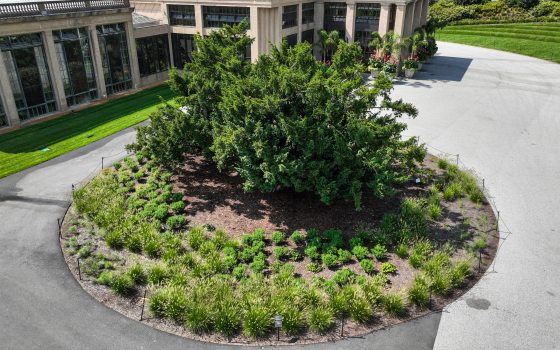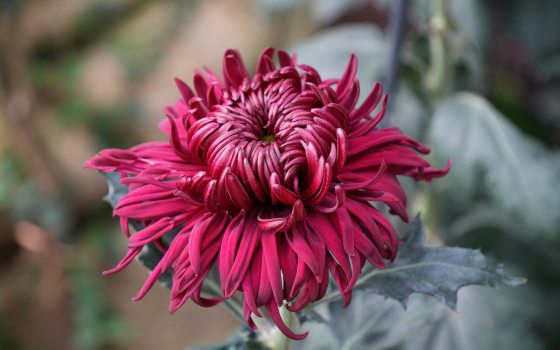If you have ever visited Longwood you have most certainly walked past a piece of history known as the East Plaza English Yew. Located at the top of the short incline before entering the Main Conservatory, this stately yew (Taxus baccata) has greeted guests for nearly a century. Planted in 1930—a little less than a decade after the historic Main Conservatory opened to guests in 1921—the tree has stood strong while overlooking the Gardens’ growth, from the building of the Main Fountain Garden (1931 and rebuilding in 2017), to the construction of the East Conservatory (originally the Azalea House) in 1973, to our 2024 opening of Longwood Reimagined. It serves as a keystone plant when entering the Conservatory District and it remains the oldest yew on the property. For the first time in its life, our East Plaza English Yew recently received a variety of neighbors—new four-season underplantings designed to accent the tree and add to its story.
Just like many early plantings, Mr. du Pont sourced large specimen trees and shrubs from up and down the east coast to fit his aesthetics and vision for the property. This yew was certainly no exception. In spring 1930, Mr. du Pont bought the champion tree from Philadelphia nursery Thomas Meehan and Sons; the tree itself was growing on a farm near Bel Air, Maryland. The journey from Maryland to where it lives today took nearly five weeks. Roads had to be closed, and power and telephone lines needed to be moved to travel the 50 miles to the East Plaza. Much of the travel had to happen at night when other traffic was not on the roads. Since its arrival it has stood with dignity ever since.

This 1931 photo is the earliest known showing the East Plaza English Yew. Photo by Dallin Aerial Survey Company.

The East Plaza English Yew in 1976, surrounded by lawn. Photo by Arthur Trimble.
The East Plaza English Yew was originally planted within a surrounding lawn. Later it was given added protection with the establishment of a mulched bed around it. Applying mulch around trees and shrubs protects the root zones and helps with moisture regulation, as well as provides nutrients to the plant as it breaks down. Then, in 2010, the East Conservatory Plaza was redesigned by renowned British landscape architect Kim Wilkie, who thoughtfully integrated the mature yew into his design.
In preserving the champion yew, Wilkie ensured that it look over the tiered landform—the first of its kind in the United States—where adults and children alike enjoy the terraced hillside while they reflect on the surrounding beauty and enjoy each other’s company. Because preserving the historic yew was a priority, Wilkie incorporated in the design a more than 60-foot diameter (over 200-foot circumference) mulched bed to protect the yew’s root zone and ensure its protection.
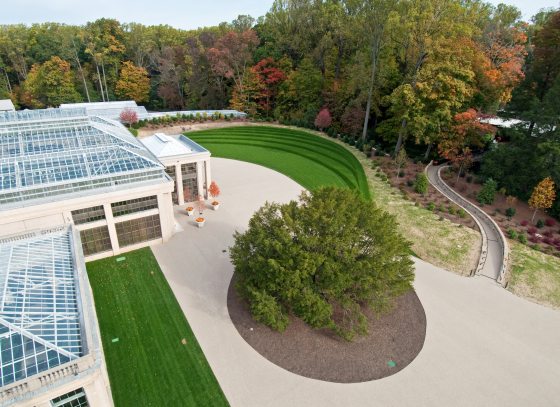
An aerial view of the new East Conservatory Plaza and English Yew, taken in 2010. Photo by Larry Albee.
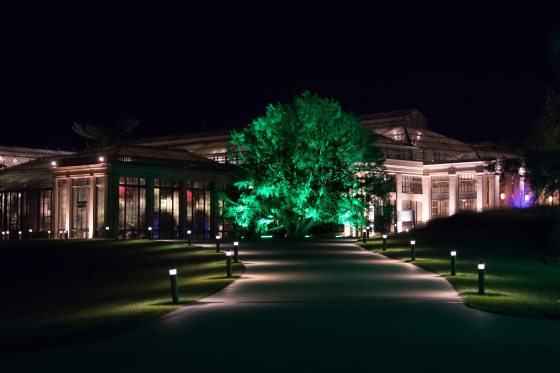
The East Plaza English Yew shines during our A Longwood Christmas display in 2017. Photo by Duane Erdmann.
After nearly a century of great health and protective efforts, the yew began to decline. Starting in 2007 more extensive resources were needed to help keep it healthy. One such long-term effort, done over several years by our team of arborists, involved a series of retrenchment pruning, as well as the installation of structural support cables. Retrenchment pruning is a technique used to manage mature and declining trees. It is a process that mimics that of natural shedding of the outer branches, encouraging the tree to rejuvenate itself from the interior.

Our arborist team prunes the yew in this 2020 shot. Photo by David Sleasman.
In addition to pruning, we also performed air spading, a plant health care technique that uses a high-pressure air knife to separate the soil from the roots. In doing this, the Plant Health Care team was able analyze the root system and add a prescribed amount of biochar, compost, and fertilizer to give the yew as much nutrients as possible. Following these extensive care methods the East Plaza yew has been recovering well, showing overall great health and consistent yearly growth.
Today, Longwood guests and staff are greeted with a revitalized, healthy yew and, as of late April, new underplantings to accent the tree: a beautiful specimen that Mr. du Pont himself selected to welcome his friends and family to the Conservatory and beyond. Keeping in mind that we wanted to accent the yew, we chose plants that would remain under three feet tall so the belle of the ball could be seen.
As we wanted year-round visual appeal, we also selected a mix of plants that provide interest throughout all four seasons. The shape of the bed is unique as well because it is circular and able to be viewed from all sides. To accommodate its shape, we laid the plants out in a pinwheel design.. As one can envision there is a north and south side to the area. Ensuring a visually cohesive planting bed from all angles was a significant design challenge, especially given the varying sun requirements of the plants. We addressed the challenge through careful placement of the plants.
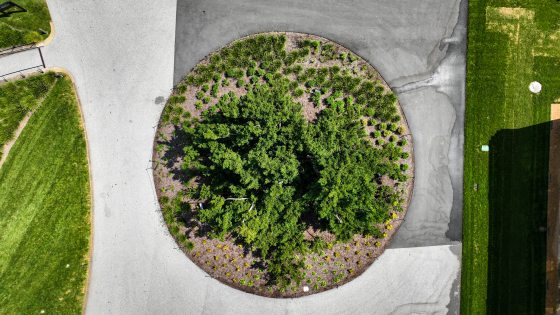
An aerial view of the East Plaza English yew and its surrounding plantings shows the circular planting bed. Photo by Carol Gross.
We chose six varieties of plants for design and all but one are native. We decided on Ilex opaca ‘Maryland Dwarf’ for an evergreen element. As a native cultivar of American Holly, the shrub form ‘Maryland Dwarf’ provides a naturalistic element that complements the surroundings while adding an evergreen presence to the design.
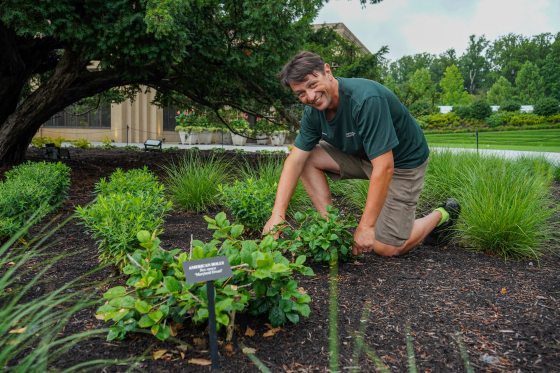
Horticulturist Jesse Armer tends to the new Ilex opaca ‘Maryland Dwarf’ plantings. Photo by Carol Gross.
To add to the blending of the surroundings, we planted Pennisetum alopecuroides ‘Hameln’ (Dwarf Fountain Grass). This is the same grass you see throughout the landform.
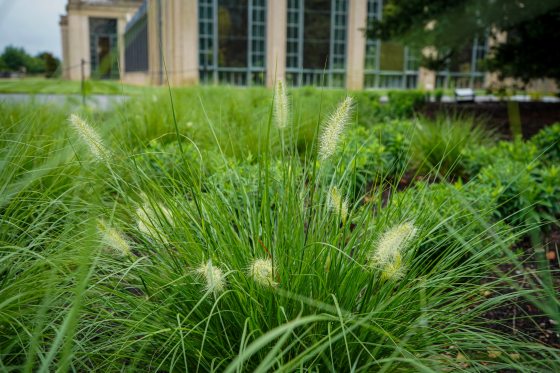
Pennisetum alopecuroides ‘Hameln’ (Dwarf Fountain Grass). Photo by Carol Gross.
As it is highly drought-tolerant, it allows for minimal maintenance while softening the look that the ‘Maryland Dwarf’ holly’s glossy leaves provide. In addition, it turns a rich sand color in the autumn to add contrast.
We chose the third plant, Amsonia hubrechtii (Threadleaf bluestar), for its foliage more so than its powder blue flower that blooms in May. Its light green feather leaves shimmer in the lightest of breezes, welcoming people to dance with it. In autumn, Amsonia fades to a golden yellow adding a fall color element to accent not only the yew but the natural woodlands in the distance—notably the Liriodendron tulipifera (tulip poplar), Carya ovata (shagbark hickory), Acer saccharum (sugar maple); or Cladrastis kentukea (American yellowwood) in front of the Main Conservatory on the Conservatory Overlook.
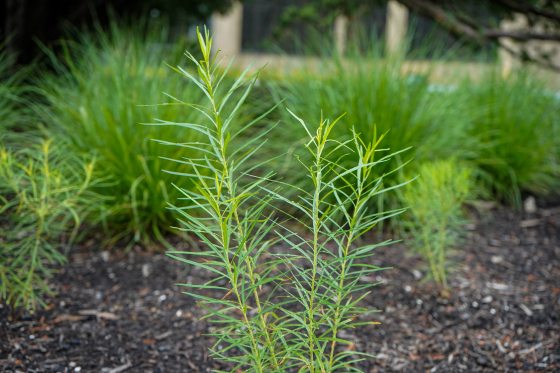
Amsonia hubrechtii (Threadleaf bluestar). Photo by Carol Gross.
Drought- and semi-sun-tolerant Dryoperis erythrosora ‘Autumn Fern’ (Japanese Shield Fern) was planted on the north side of the yew. This fern’s colors are like no other, having bronze, copper, green, and even golden undertones. In addition, it has foliage year-round making it a great selection to always look at.
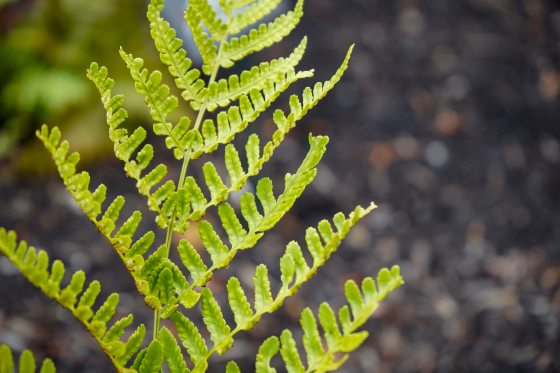
Dryoperis erythrosora ‘Autumn Fern’ (Japanese Shield Fern). Photo by Carol Gross.
We also planted the native Erigeron pulchellus var. ‘Lynnhaven Carpet’ (Fleabane), a perennial that offers that of its namesake: a carpet. This great shade, and even sun-tolerant plant, was planted on the north side of the yew. Also evergreen, it adds interest during all seasons, including in late April and May with its white to pale pink aster-resembling flowers.
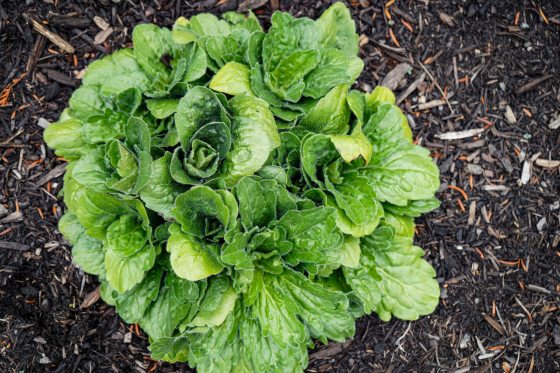
Erigeron pulchellus var. ‘Lynnhaven Carpet’ (Fleabane). Photo by Carol Gross.
To complement the Erigeron on the sunny (south) side and showcase the yew, we also planted Symphyotrichum novae-angliae ‘Purple Dome’ (New England Aster) amongst the Amsonia, Pennisetum, and Ilex. ‘Purple Dome’ is a dwarf aster that blooms prolifically in early fall with purple petals and yellow pistils, or centers.
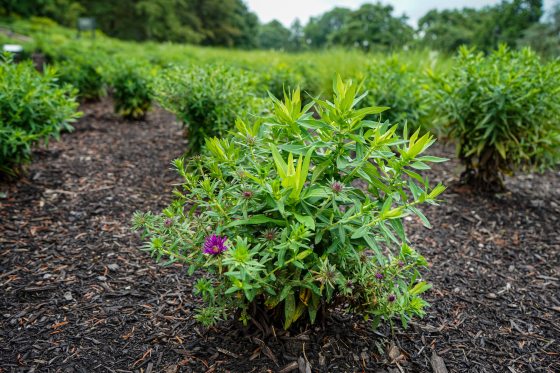
Symphyotrichum novae-angliae ‘Purple Dome’ (New England Aster), just coming into flower. Photo by Carol Gross.
With all the newly added textures and soft pops of color around the storied East Plaza English Yew, this historic yew now has an ever-evolving, next-generation plant community to keep it company, and to help our guests enjoy its beauty and experience how majestic its history and placement within Longwood truly is. Next time you are in the Gardens make sure to stop by and experience its grandeur for yourself while taking in all the beauty around you.
